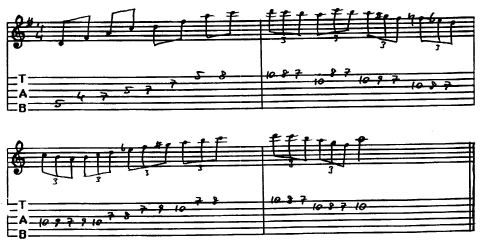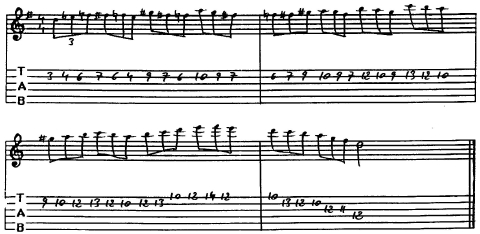In this column we are going to use the diminished scale in conjunction with the Mixolydian scale to achieve an interesting sound, and go "in and out" of the diatonic scale. The patterns and some exercises for the diminished scale can be found in Part 2. For a deeper examination of the Mixolydian scale (and the other modes) check out the column of fellow columnist Mike Campese, The Modes.
The following licks over a D7 chord are examples of how the diminished scale can be combined with the Mixolydian scale to play "outside" and then return to the diatonic scale.
The diminished scale in D is:
D Eb F F# G# A B C
The Mixolydian scale in D is:
D E F# G A B C
Lick 1 starts with a D7 arpeggio in the fourth/fifth position. After the arpeggio we change to the D diminished scale in the seventh position for two bars before returning to the Mixolydian scale in bar four. Along with the change to the diminished scale we also speed up the lick by using eight note triplets.

MP3 - Lick 1
Lick 2 begins outside right away with a two bar sequence in triplets. The first two bars are entirely played on the B-string. The lick resolves to the Mixolydian scale during the third bar. Notice that the D Mixolydian scale and the D diminished scale share the same notes in the tenth position on the B-string so you don't realize the change to the Mixolydian scale until the fourth beat of bar three when the ninth (E natural) comes in. This makes the scale change sound very natural and smooth.

MP3 - Lick 2
Try coming up with some own licks combining the diminished and Mixolydian scales. We will examine some more ways to play "outside" in subsequent columns. Feel free to contact me via e-mail with any questions or comments. Please check out the soundfiles of my two solo CDs and visit my web site.
Martin Behr is a guitarist from Germany who has studied at M.G.I. (Munich's Guitar Institute), released two solo CDs, and stays busy with studio sessions.
His latest CD is entitled "Law Of The Jungle", which documents his command of many musical styles, his great technique, his tone and feel.